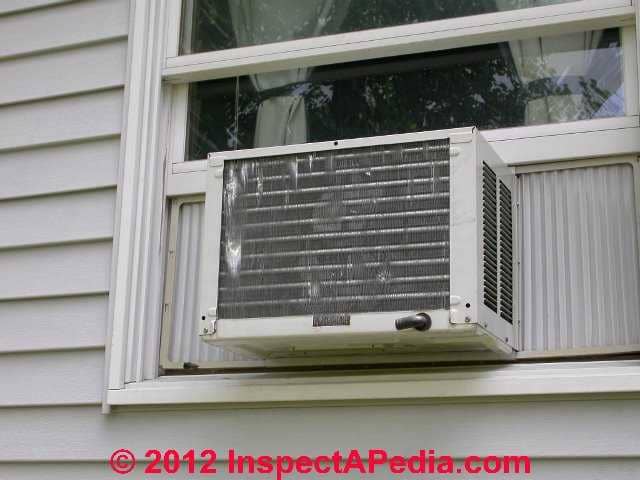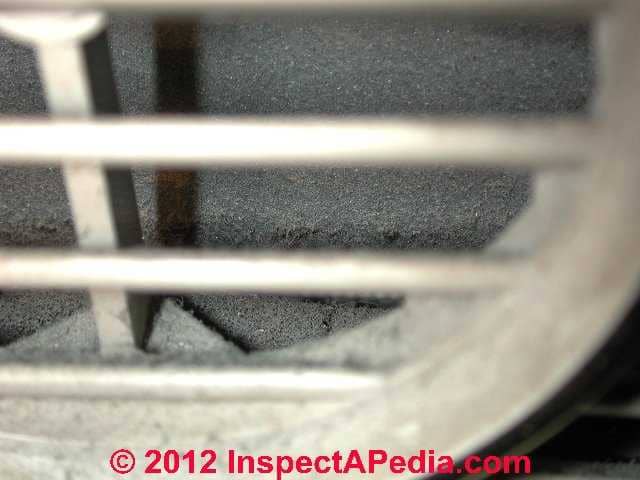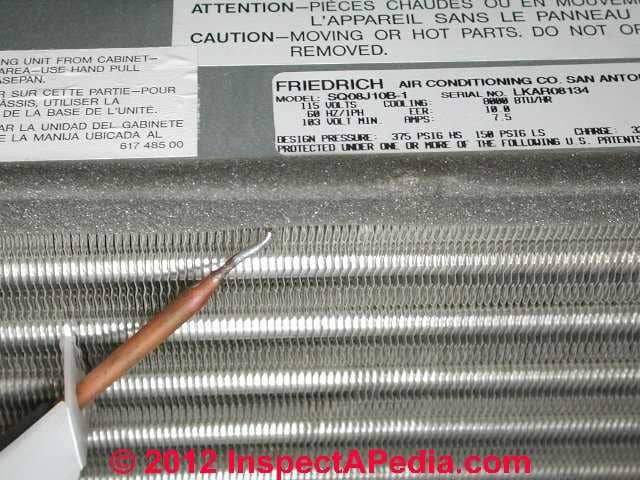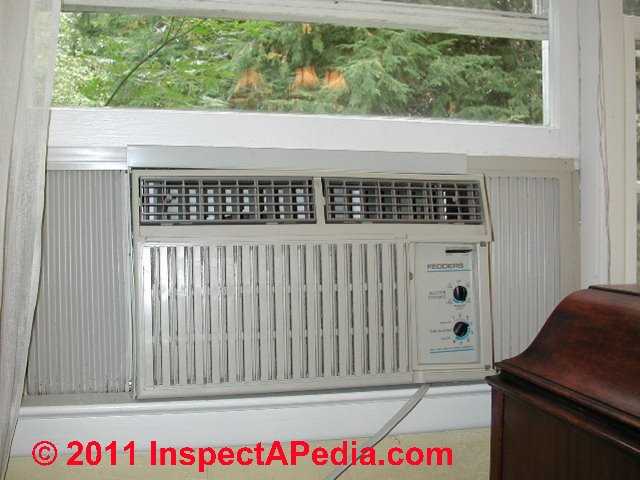 Window Air Conditioner Repair
Window Air Conditioner Repair
Install, clean, remove mold, or fix a window or through-wall A/C unit
- POST a QUESTION or COMMENT about window air conditioners & through-wall air conditioners
Window air conditioners:
This article helps choose, install, maintain & troubleshoot window and through-wall air conditioners.
We describe the simple process of installing or removing a window air conditioner, how the unit should be stored when not in use, and we explain what to do if the air conditioner condensate draining onto a location where it's causing trouble.
We include additional details about window and through-wall cooling unit capacity, safety supports, filters, compressor/condenser troubleshooting, dirt and mold cleanup, and other issues.
InspectAPedia tolerates no conflicts of interest. We have no relationship with advertisers, products, or services discussed at this website.
- Daniel Friedman, Publisher/Editor/Author - See WHO ARE WE?
Window Air Conditioner Units: installation, maintenance, storage, troubleshooting, cleaning
Article Contents
- WINDOW A/C UNIT INSTALLATION TIPS
- WINDOW / THROUGH-WALL A/C REMOVAL & STORAGE
- CONDENSATE HANDLING for WINDOW/WALL A/C UNITS
- CLEAN the WINDOW / WALL A/C AIR FILTER
- CLEANING MOLD on or in a WINDOW / Wall A/C SYSTEM
- CLEAN the WINDOW / WALL A/C COOLING COIL
- LINKS to WINDOW A/C UNIT REPAIR PROCEDURES
...
Typical Window Air Conditioner Installation
As we discuss also at WINDOW / WALL A/C SUPPORTS, at below left the accordion-type expanding window-mounted air conditioner opening bracket upper edge, braced against the lower edge of the window sash, is the principal connection that keeps this unit from falling out of the window opening.
Watch out: both during window air conditioner installation and more so when you are removing the unit at the end of the cooling season, simply raising the window sash can result in the whole assembly falling off of the building.
Short screws, often sheet metal screws secure the expanding bracket and window-filler on the sides of the air conditioner to the window sash bottom edge near the left and right ends of the upper sliding metal bracket.
And two additional screws secure the accordion expanding fillers to the trim on either side of the window frame.
These little screws are not structural and do not provide much additional security against losing the whole air conditioner out the window.
The outside view of this type of window air conditioner makes clear that it has no other support.
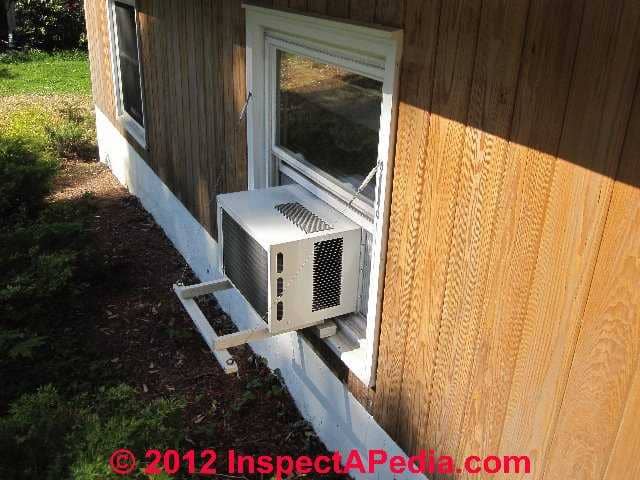
Watch out: inadequately-supported outdoor window air conditioners or inadequately-supported wall-mounted outdoor compressor/condenser units (referred to as the "inverter unit" in some literature) pose a potentially fatal hazard should one of these units fall from the building onto someone below.
In 2012 the New York Times reported that that city has increased enforcement of proper exterior supports for air conditioners at public housing after air conditioning units fell out of two windows in a housing project on the upper East Side of New York City.
In 1988 a pedestrian was killed when an air conditioner fell from the seventh floor of a building in New York. [5]
While those air conditioner falls, one onto a playground near children, luckily didn't hurt anyone a falling A/C unit (window air conditioners) or compressor/condenser unit (split system air conditioners with an outside wall-mounted compressor unit) are very dangerous.
Details about the support requirements for window and through wall air conditioners are
...
Proper Methods for Removing & Storing a Window Air Conditioner
Heavy through-window air conditioners and most through-wall air conditioners are left in place year round. But because of possible air drafts and heat losses through the equipment during cold windy weather, many owners either cover those units or for smaller window air conditioners such as the unit shown just above, the unit is removed and stored.
When a window air conditioner unit is to be removed and stored at the end of the cooling season
- Watch out for condensate spillage into the room when you are removing the unit. There may be dirty A/C condensate in the bottom of the unit. We place a towel on the floor under the window to avoid a mess while removing the unit.
- With an assistant holding the window A/C unit so that you do not drop it out of the window during removal, just remove the screws that secure the expanding window unit surround to the window sash or side trim.
- Next push the accordion sliding closures towards the air conditioner body - you'll now be able to see outside.
- Because the according sliding closure assembly should itself have been screwed to the air conditioner body, you should be able to grasp the entire assembly, holding it securely while your assistant then lifts the window sash upwards to permit sliding the window unit into the room.
If the unit is heavy it may take two people to lower it gently onto the towel you've placed on the floor. - Wipe off and clean the unit before storing it.
- Store the air conditioner upright - that is in the same position as it will be when it is installed and working.
Watch out: if you store a window or through-wall air conditioner in any other position there is risk that refrigerant and oil will move into and clog the capillary tube that meters refrigerant.
If you turn on an air conditioner where this mistake was made, on some window air conditioners the unit won't work - the motor may run but it won't produce cool air.
Usually you can "fix" this mistake by simply leaving the unit in its proper position for 24 hours, giving oil time to flow back out of the refrigerant line and cap tube.
...
Window Air Conditioner Condensate Disposal
How to route condensate from a window air conditioner
Does anyone have a good idea for a Window AC drip pan? The window its in is above a door. Maybe a good DYI website? - Brian B. 7/15/12
Reply:
Brian: about window A/C unit condensate drip pans and condensate disposal troubles:
A window or through-wall air conditioner already includes a condensate drip pan inside the unit. Our photo at left illustrates the drip tray in a window air conditioner.
The drip pan includes a condensate drain port that either drips directly out of the bottom back of the unit, usually at a corner, or the port, a small metal tube, can be connected to a drain hose to route condensate to an acceptable location so that it does not drip, for example, on the head of someone walking below.
That's a particular problem when the A/C unit is installed over a door as we often see at business entrances.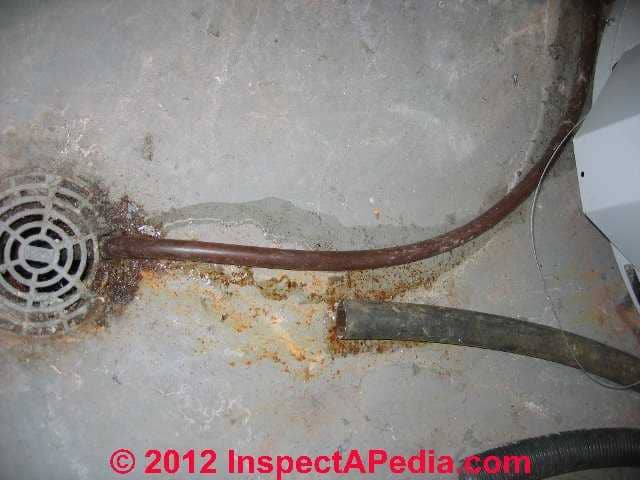
Best practices to control condensate dripping from a window or over-door air conditioner include:
- make sure that the unit is properly leveled or slopes slightly towards the outdoors - else condensate can overflow the pan sides and leak into the building or into an uncontrolled location.
- make sure that the drain port at the unit's condensate drip tray has not become clogged with dust and debris.
Often a toothpick or soft small wire can clean out crud blocking that opening without having to disassemble anything. (Don't jam a wire way into the unit as you may cause damage) - connect a plastic condensate drain hose to the window A/C unit drip port or pan to collect and route condensate down the building wall or door frame to the ground so that it does not drip onto people.
Watch out: in some municipalities it is not permitted to drain A/C condensate across a sidewalk - in such cases the property owner has to route condensate to a floor drain or similar location.
When there is no drain close by that can be reached by gravity, you can still solve this problem easily by having the A/C condensate routed to a small condensate pump that then pumps condensate to an acceptable drain location.
...
Window AC Filter Cleaning
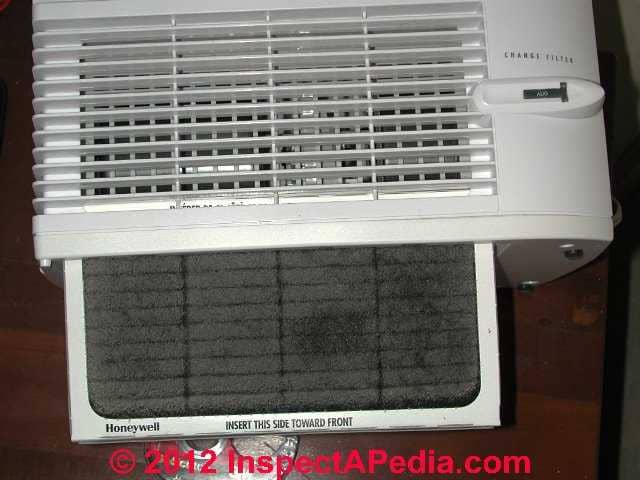
Clean the air conditioner filters monthly during the cooling season. This is the single most important step you can take to keep your unit working effectively.
On some units (left) the air conditioner filter slides up or down for removal and washing.
On other window or room air conditioners you have to un clip and remove the entire front cover to access, remove, and clean the air filter.
If the air filter is a sheet of foam that is torn or disintegrating, just replace it. You can usually find replacement window air conditioner filter materials at building supply stores.
The new filter may have to be trimmed to fit.
On other units such as the photo at left, just peeking through the air inlet openings you can see if the filter surface has become thick and clogged with dust and debris.
The window unit air conditioner air filter in our photo needs to be cleaned or replaced.
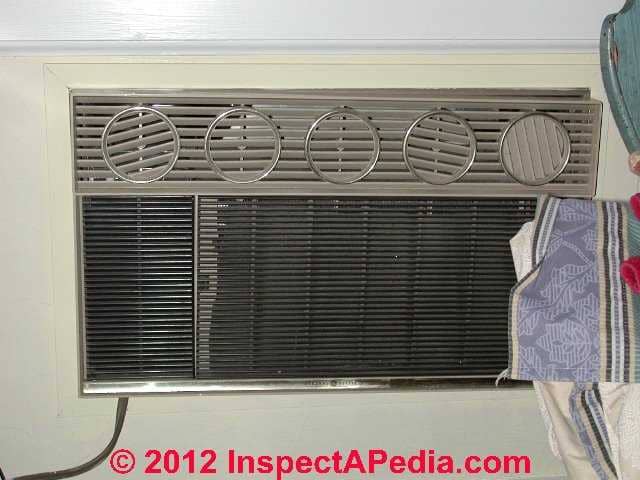
When you have completed your air conditioner and filter cleanup, make sure that the room or window air conditioner front cover is properly and squarely mounted and secured.
If the cover is loose you may be annoyed by rattles and noises coming from the unit.
The room air conditioner shown at left is an older unit whose controls are behind an openable panel at the left side of the unit.
You can see that the unit cover is askew (upper right corner) and is not properly secured.
On one of our older air conditioners the springs that held the cover in place were lost. An expedient that was ugly but worked fine was simply to use some duct tape to secure the plastic cover to the air conditioner frame. The tape has to be peeled away and replaced each time the cover is removed to access and clean the air filter.
In sum, remember to check for thick accumulated dust and debris when you are changing or cleaning your window or wall-mounted air conditioner air filters.
Also check the cleanliness of the the unit cover itself.
Both the air intake and air supply louvers can become thick with dust - blocking air flow as well as possibly adding to airborne dust and debris as well as speeding clogging of the unit's air filter.
When we see an air conditioner as dirty as this one we figure it has had little maintenance or attention and that it needs cleaning.
On some room or window air conditioners it's easy to know if the air filter needs washing or replacement.
Some air conditioner units actually provide a signal: a light or a red indicator showing that the air filter is blocked, air flow is reduced, cooling capacity is reduced, and the unit needs cleaning.
...
Window AC Mold Contamination Cleanup

If you see mold growth on or inside the air conditioning unit you may want to turn it off, remove and wash the plastic cover fittings and parts, and working gently so as not to bend or break anything, manually clean the accessible portions of the blower fan and air passages.
We remove the air conditioner's front cover assembly (you may need to pull off control knobs first on some older units), and carry it either to large kitchen or laundry sink for cleaning, or we do the cleanup outdoors.
Any household cleaner, spray diluted bleach, etc. can be used to clean these plastic surfaces.
For a detailed step by step demonstration of cleaning a moldy A/C unit, using a wall-mounted split system as a model, see
SPLIT SYSTEM AC MOLD CONTAMINATION REMOVAL
If the squirrel cage blower fan is accessible, check the fan blades for accumulated dust and debris or mold - and spray those as well. I use a soft paint brush to help loosen debris since I find that those long bristles are soft enough and long enough brush off the fan blades without bending anything.
Watch out: avoid spraying a lot of cleaner onto the bearing ends of the blower fan or you may lose lubricant and damage the fan.
Window AC Cooling Coil Cleaning
Cleaning Procedures for Dirty window air conditioner or room air conditioner cooling coils
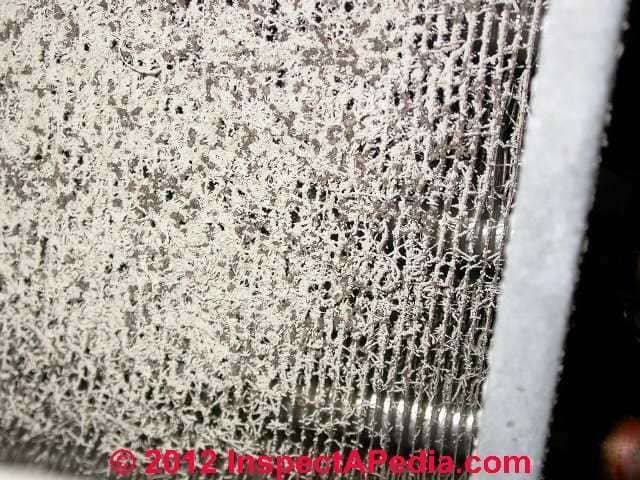
Our photo shows what happens if you operate a window or room air conditioner with no air filter installed. The cooling coil fins become blocked and clogged with dust and crud.
This reduction in air flow cuts the cool air output of the air conditioner and can eventually lead to complete loss of function as the unit can also begin to ice-up.
There are several approaches to cleaning up a mess like this - all of them should be followed with care not to bend or damage the cooling coil fins as doing so reduces air flow through the air conditioner. Some options include:
- Gently clean the coil fins with a vacuum cleaner and brush attachment, moving the brush ONLY parallel to the fin directions so that you don't bend anything
- Gently brush the cooling coil fins clean with a hand-held bottle brush or similar soft bristle brush, taking care not to bend the fins.
- Use a manufacturer recommended spray-on cooling coil cleaner, following the directions on that product.
Typically a foam cleaner tries to wash lint and debris down the coil face where it may drain out the condensate pan and drain (risking clogging it with dirt) or it may drip onto newspaper spread below the unit.
When cleaning the cooling coil itself we use the same spray cleaner, catching runoff on an old towel. You can use a soft brush to clean the cooling coil fins and also the blower fan blafdes if they're badly clogged with debris.

Watch out: Take care not to bend or damage the cooling coil fins.
Coil cleaning products and more details are
...
Window or Through Wall Air Conditioner Operating Problems
If the air conditioner won't start make sure that its controls are set for cooling and that the unit has power.
If the air conditioner will start and run, and air blows out of the supply register but it never cools, make sure that the thermostat is set all the way to the coldest position. If the unit still won't produce cool air it needs service or repair. The unit may have lost its refrigerant charge.
But before calling your service technician, if you have just installed the air conditioner, and if it is new, or if it was working when last removed, you may have stored it in an improper position, allowing refrigerant oil to block a refrigerant metering device or capillary tube.
Try leaving the unit off but in proper operating position for 24 hours, then try turning it on again.
If you don't have the installation, operation, and maintenance guide for your window or room air conditioner, check the model and serial number (see our photo at above left) and then contact your unit's manufacturer
- For quick air conditioner or heat pump troubleshooting that can be done by many building owners or occupants,
Start Here: DIAGNOSTIC GUIDE A/C or HEAT PUMP - quick easysteps to diagnose an air conditioner or heat pump. - For detailed troubleshooting and procedures used by trained HVAC repair technicians, see our list of detailed diagnosis and repair procedures at
DIAGNOSTIC DETAILS A/C or HEAT PUMP - If you just want to know how an air conditioner or heat pump works,
see HOW an AIR CONDITIONER WORKS
...
...
Reader Comments, Questions & Answers About The Article Above
Below you will find questions and answers previously posted on this page at its page bottom reader comment box.
Reader Q&A - also see RECOMMENDED ARTICLES & FAQs
How do I Test my Window Air Conditioner Unit for Mold Contamination?
The interior of our window air conditioner AC) has collected a dark substance which is suspicious for mold. This is not a legal case at all. We want to collect a sample and send it to a lab to verify the presence of mold and have the lab report to us the type of mold that was sampled.
We intend on discarding the window AC, and this is not a legal matter. We own the external window AC and are ready to dispose of it, and consider this the cost of operating a window AC in our area. There is no suggestion of mold inside the home.This is simply to verify the existence of mold in the window AC because we know it is essentially a disposable device that we must repurchase once a year in our location.
In conclusion, we would appreciate your suggestions on a lab that we could contact who would advise us on how to collect and send a specimen to them in order to confirm the presence and type of mold inside our window AC.We do not need to test for the presence of mold inside the home or anywhere else. - Anonymous by email 2024/09/08
Reply by InspectApedia Publisher (mod)
@Moldy Window AC Unit (Anonymous),
I will provide a link below that suggests some mold test labs, but rather than set you loose with mold "test kits" on your window air conditioner, permit me to say a bit more so that we don't waste your time and money or lest we obtain a false or misleading mold test result.
It's worth noting first, Lynn, that knowing the type of mold found by your window AC unit test would not change what would be needed for a mold-contaminated air conditioner: clean the unit thoroughly. Then check to see if there's an operating problem that contributes to mold growth, such as improper condensate drainage or in a window unit, improper slope to drain to the building exterior.But indeed I find mold growing in air conditioning equipment even when it's properly installed and working correctly.
Watch out: when sampling mold in an air conditioner to send to a test lab, because different mold/genera species grow on (and prefer) different materials, you will find that the molds (there will be more than one, often quite a few) growing on the metal blades of a squirrel-cage fan are quite different from those growing on plastic surfaces in an A/C unit and those groups may both differ from those found growing on an air conditioner filter.
That means that NO single test is going to give a complete nor even perhaps the most accurate picture of what mold is growing inside of an air conditioner unit.
To make an accurate test of what's inside the unit you'd want several samples, perhaps 3 to 5, and you'd need to be sure to use the proper type of sample collection (a tape sample, NOT a swab sample which destroys mold-identifiying features that we need when examining a sample under the microscope, and NOT a mold culture test which is 90% "wrong" at the outset because only about 10% of all molds will grow in any culture media, and those that do are those that like the culture best, not necessarily those that are most abundant in a mold test sample.)
So I prefer to use the moldy surface test method I've described
at TAPE & BULK SAMPLING & TESTS for MOLD
Still if you want to have a representative sample (or more than one sample) of the material tested, some test labs as well as environmental test consultants who can collect a sample (if you don't know how to do that yourself) are listed at
ENVIRONMENTAL & MOLD TESTING SERVICES
I have dis-assembled and cleaned moldy air conditioners a number of times, using ordinary household cleaners (spray bleach or even windex). The need for cleaning may not be a reason to throw out a window A/C unit unless it's quite antiquated or has other operating problems.
This article
SPLIT SYSTEM AC MOLD CONTAMINATION REMOVAL
shows how we do that. It's for a wall- mounted split-system A/C unit.
Most window AC units are easier to clean, particularly if it's easy to remove the external metal or plastic cover of the unit.
Watch out: however to follow safe cleaning procedures: that means don't get cleaner in your eyes nor touch your eyes if your hands are dirty with moldy debris.
Daniel
Window A/C unit condensate drip pans and condensate disposal troubles:
Does anyone have a good idea for a Window AC drip pan? The window its in is above a door. Maybe a good DYI website? - On 2012-07-14 by Brian B
Reply by (mod) - Window A/C unit condensate drip pans and condensate disposal troubles:
Brian: about window A/C unit condensate drip pans and condensate disposal troubles:
A window or through-wall air conditioner already includes a condensate drip pan inside the unit.The drip pan includes a condensate drain port that either drips directly out of the bottom back of the unit, usually at a corner, or the port, a small metal tube, can be connected to a drain hose to route condensate to an acceptable location so that it does not drip, for example, on the head of someone walking below.
That's a particular problem when the A/C unit is installed over a door as we often see at business entrances.
Best practices to control condensate dripping from a window or over-door air conditioner include:
- make sure that the unit is properly leveled or slopes slightly towards the outdoors - else condensate can overlow the pan sides and leak into the building or into an uncontrolled location.
- make sure that the drain port at the unit's condensate drip tray has not become clogged with dust and debris. Often a toothpick or soft small wire can clean out crud blocking that opening without having to disassemble anything. (Don't jam a wire way into the unit as you may cause damage)
- connect a plastic condensate drain hose to the window A/C unit drip port or pan to collect and route condensate down the building wall or door frame to the ground so that it does not drip onto people.
Watch Out: in some municipalities it is not permitted to drain A/C condensate across a sidewalk - in such cases the property owner has to route condensate to a floor drain or similar location.When there is no drain close by that can be reached by gravity, you can still solve this problem easily by having the A/C condensate routed to a small condensate pump that then pumps condensate to an acceptable drain location.
Brian, we've taken your suggestion and have begun adding advice specific to window air conditioner units.
Can I Use an Old Door Screen for a Window A/C Unit Filter
Can I use the screen wire from an old door as a filter for a window unit a/c? - 2020-06-13 00:02:39.384192
by Becky
Reply by danjoefriedman (mod) - converting window screen mesh openings to inches or mm shows that a window screen not a good A/C air filter
Becky
Sorry to say a door screen won't be an effective air filter.
During the COVID-19 pandemic or future similar pandemics, if you were facing an emergency need for an air filter the screen, over the air intake, a window screen might reduce some dust and debris, and as you run the window A/C unit for days or weeks, the accumulation of dust on the screen reduces the opening sizes and thus actually improve the effectiveness of the screen as a dust filter.But the openings in a window screen mesh size is rated as "16 x 18" meaning that there area 1-inch high area of the screen has about 16 openings and a 1 inch wide area has about 18 openings. That makes each opening about 0.03 x 0.05 inches or 1.2 x 1 mm in size - not effective as a dust filter.
What is the proper slope or tilt for a window air conditioner to drain properly?
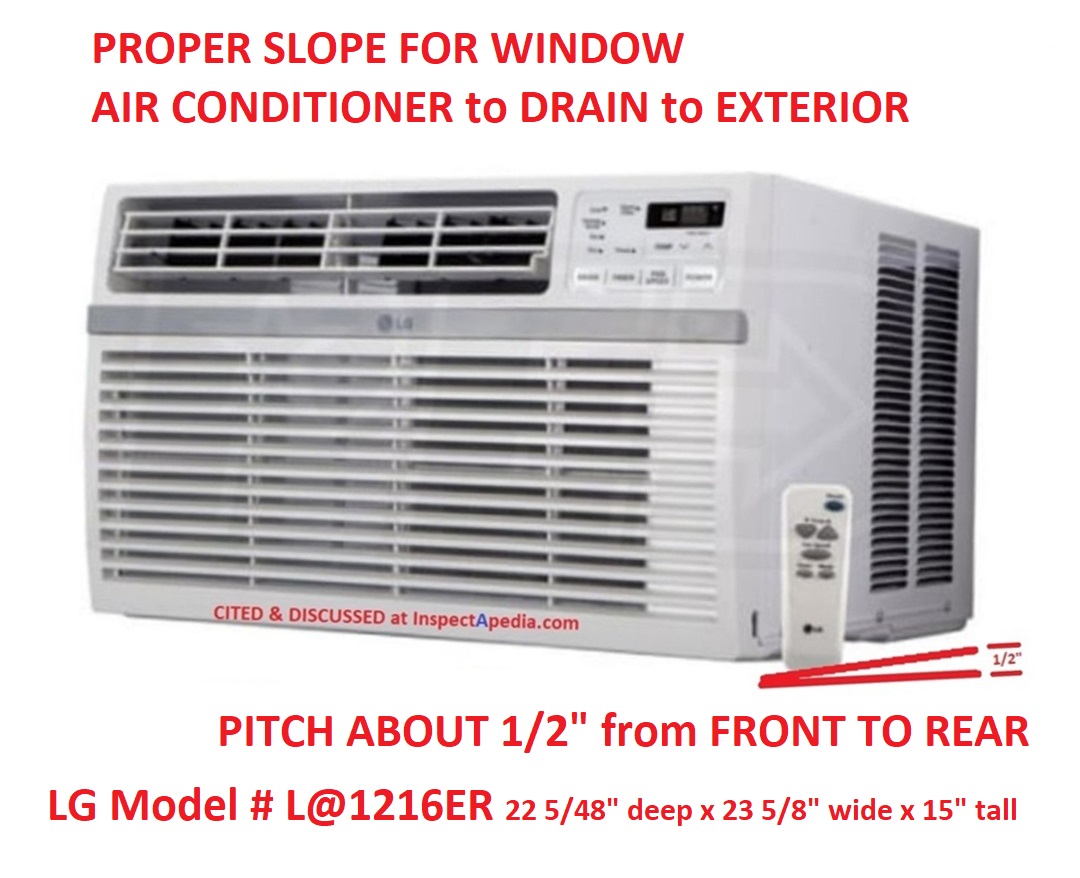 When installing a window unit does the front have to be slightly facing downward in the back a little bit up or is it the opposite way for correct draining? - On 2018-05-13 by Nicole farris
When installing a window unit does the front have to be slightly facing downward in the back a little bit up or is it the opposite way for correct draining? - On 2018-05-13 by Nicole farris
Reply by (mod) - Slope a window A/C unit about 1/2" from front to rear
Nicole
We install the window air conditioner such that the outdoor end of the unit is tipped slightly downwards.This helps a sure that the condensate that the unit produces will drain out of the unit and to the outside rather than draining into the building interior.
It's ok if the unit slopes a bit more than 1/2" but don't make it excessive or you may compromise the support system and the unit could fall out of the window (very dangerous).
Comment by Benjamin Brackman
@Nicole farris,
The back of the air conditioner should be tilted down about 1 degree (about 6 inches) to allow for proper drainage.
Reply by (mod) - 6 inches is way too much slope for a window AC unit !
Thanks for the comment, Benjamin.
What is the proper slope for a window air conditioner?
I agree that the window A/C needs to be sloped so that condensate drains to the building exterior.
However 6-inches of tilt from front to back for typical window A/C unit would be extreme and incorrect and a heck of a lot more than 1 degree.
Take a look at the LG Model: LW1216ER window A/C unit shown here.This unit has a "depth" of 22 5/48 inches.
If you tipped this unit 6-inches towards the outside that would be a slope of 6 in 22 inches or a 27% slope or roughly 14 degrees of slope.
A 6-inch tilt would be extreme.
A typical window air conditioner needs only a very slight slope, about 1/2-inch from interior face to exterior face, to drain properly.Check the installation instructions from the manufacturer of your specific window air conditioner to be sure you have the right slope for window unit drainage.
Larger or heavier window or through-wall window A/C units may need additional support; see details
...
Continue reading at WINDOW / WALL A/C SUPPORTS or select a topic from the closely-related articles below, or see the complete ARTICLE INDEX.
Or see WINDOW / WALL AIR CONDITIONER REPAIR FAQs - questions and answers posted originally on this page
Or see these
Recommended Articles
- AIR CONDITIONER BTU CHART - choose a window or through-wall air conditioner of the right size or capacity
- AIR CONDITIONER COVER USE
- DIAGNOSTIC GUIDE A/C or HEAT PUMP
- DIRTY HVAC COIL CLEANING PROCEDURES
- PORTABLE AIR CONDITIONER BTU CHART - portable room air conditioner BTU sizing advice
- SPLIT SYSTEM AC MOLD CONTAMINATION REMOVAL - also works for window and through-wall A/C units
- WINDOW / WALL AIR CONDITIONERS
- WINDOW / WALL A/C SUPPORTS
Suggested citation for this web page
WINDOW / WALL AIR CONDITIONERS at InspectApedia.com - online encyclopedia of building & environmental inspection, testing, diagnosis, repair, & problem prevention advice.
Or see this
INDEX to RELATED ARTICLES: ARTICLE INDEX to AIR CONDITIONING & HEAT PUMPS
Or use the SEARCH BOX found below to Ask a Question or Search InspectApedia
Ask a Question or Search InspectApedia
Try the search box just below, or if you prefer, post a question or comment in the Comments box below and we will respond promptly.
Search the InspectApedia website
Note: appearance of your Comment below may be delayed: if your comment contains an image, photograph, web link, or text that looks to the software as if it might be a web link, your posting will appear after it has been approved by a moderator. Apologies for the delay.
Only one image can be added per comment but you can post as many comments, and therefore images, as you like.
You will not receive a notification when a response to your question has been posted.
Please bookmark this page to make it easy for you to check back for our response.
IF above you see "Comment Form is loading comments..." then COMMENT BOX - countable.ca / bawkbox.com IS NOT WORKING.
In any case you are welcome to send an email directly to us at InspectApedia.com at editor@inspectApedia.com
We'll reply to you directly. Please help us help you by noting, in your email, the URL of the InspectApedia page where you wanted to comment.
Citations & References
In addition to any citations in the article above, a full list is available on request.
- In addition to citations & references found in this article, see the research citations given at the end of the related articles found at our suggested
CONTINUE READING or RECOMMENDED ARTICLES.
- Carson, Dunlop & Associates Ltd., 120 Carlton Street Suite 407, Toronto ON M5A 4K2. Tel: (416) 964-9415 1-800-268-7070 Email: info@carsondunlop.com. Alan Carson is a past president of ASHI, the American Society of Home Inspectors.
Thanks to Alan Carson and Bob Dunlop, for permission for InspectAPedia to use text excerpts from The HOME REFERENCE BOOK - the Encyclopedia of Homes and to use illustrations from The ILLUSTRATED HOME .
Carson Dunlop Associates provides extensive home inspection education and report writing material. In gratitude we provide links to tsome Carson Dunlop Associates products and services.


